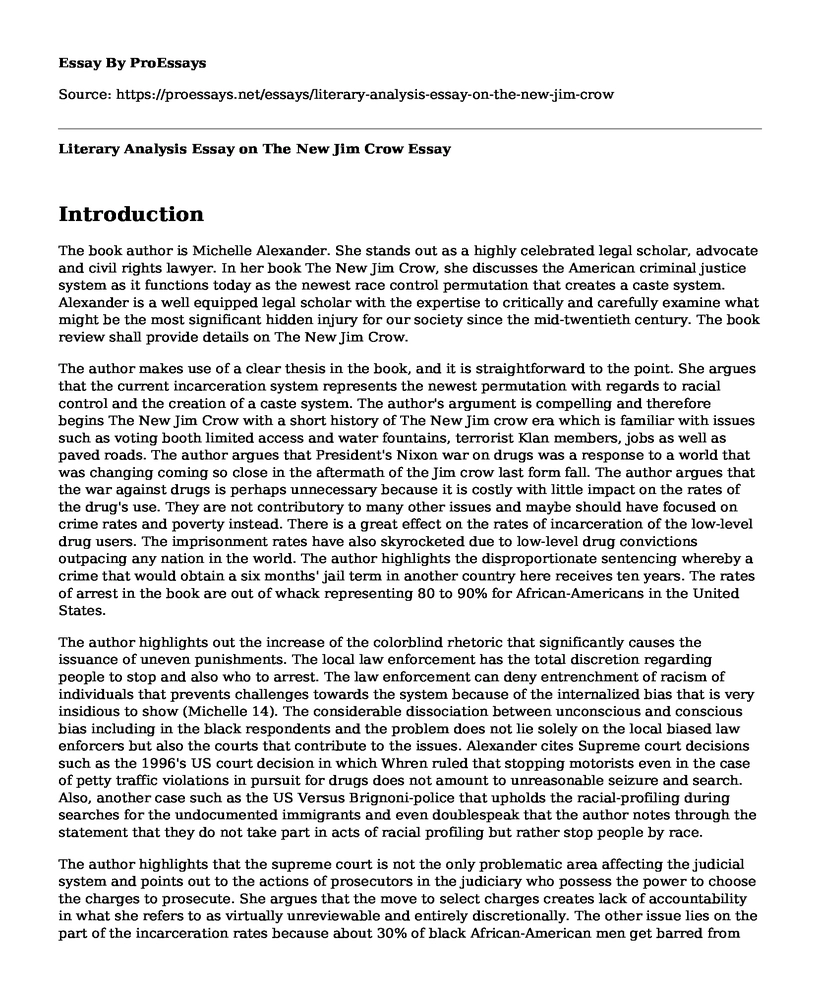Introduction
The book author is Michelle Alexander. She stands out as a highly celebrated legal scholar, advocate and civil rights lawyer. In her book The New Jim Crow, she discusses the American criminal justice system as it functions today as the newest race control permutation that creates a caste system. Alexander is a well equipped legal scholar with the expertise to critically and carefully examine what might be the most significant hidden injury for our society since the mid-twentieth century. The book review shall provide details on The New Jim Crow.
The author makes use of a clear thesis in the book, and it is straightforward to the point. She argues that the current incarceration system represents the newest permutation with regards to racial control and the creation of a caste system. The author's argument is compelling and therefore begins The New Jim Crow with a short history of The New Jim crow era which is familiar with issues such as voting booth limited access and water fountains, terrorist Klan members, jobs as well as paved roads. The author argues that President's Nixon war on drugs was a response to a world that was changing coming so close in the aftermath of the Jim crow last form fall. The author argues that the war against drugs is perhaps unnecessary because it is costly with little impact on the rates of the drug's use. They are not contributory to many other issues and maybe should have focused on crime rates and poverty instead. There is a great effect on the rates of incarceration of the low-level drug users. The imprisonment rates have also skyrocketed due to low-level drug convictions outpacing any nation in the world. The author highlights the disproportionate sentencing whereby a crime that would obtain a six months' jail term in another country here receives ten years. The rates of arrest in the book are out of whack representing 80 to 90% for African-Americans in the United States.
The author highlights out the increase of the colorblind rhetoric that significantly causes the issuance of uneven punishments. The local law enforcement has the total discretion regarding people to stop and also who to arrest. The law enforcement can deny entrenchment of racism of individuals that prevents challenges towards the system because of the internalized bias that is very insidious to show (Michelle 14). The considerable dissociation between unconscious and conscious bias including in the black respondents and the problem does not lie solely on the local biased law enforcers but also the courts that contribute to the issues. Alexander cites Supreme court decisions such as the 1996's US court decision in which Whren ruled that stopping motorists even in the case of petty traffic violations in pursuit for drugs does not amount to unreasonable seizure and search. Also, another case such as the US Versus Brignoni-police that upholds the racial-profiling during searches for the undocumented immigrants and even doublespeak that the author notes through the statement that they do not take part in acts of racial profiling but rather stop people by race.
The author highlights that the supreme court is not the only problematic area affecting the judicial system and points out to the actions of prosecutors in the judiciary who possess the power to choose the charges to prosecute. She argues that the move to select charges creates lack of accountability in what she refers to as virtually unreviewable and entirely discretionally. The other issue lies on the part of the incarceration rates because about 30% of black African-American men get barred from jury duty in most cases for life in part as a result of bias by the prosecutor.
Conclusion
In conclusion, the book is remarkable. However, there are a few weaknesses. The first, the author calls out the civil rights organizations however she does not offer a similar critique to the faith communities. Therefore, can the new struggle be successful without the prophetic voices, the prophetic vision and also what Gandhi identified as "soul force." Secondly, the author's use of "a one-vote margin" phrase to prove how close a supreme court verdict was not appropriate. Anyone who reviews the recent court rulings that raise controversy will note that all determinations are almost with the one-vote margin which is a result of the polarization of the court and also there are no that many injustices. The other weakness was the author's point that the US citizens have the permission to hate the criminals universally. The book is remarkable and highly recommendable to any reader.
Works Cited
Michelle, Alexander. "The new Jim Crow: Mass Incarceration in the age of colorblindness." (2010): 14.
Cite this page
Literary Analysis Essay on The New Jim Crow. (2022, Jun 16). Retrieved from https://proessays.net/essays/literary-analysis-essay-on-the-new-jim-crow
If you are the original author of this essay and no longer wish to have it published on the ProEssays website, please click below to request its removal:
- Literary Analysis Essay on The Prince and Hamlet
- The Short Story of Junot Diaz Essay Example
- Essay Sample on U.S. Joins WW1 After Neutrality: Wilson's Reluctance
- Essay Sample on Rare Pre 19th Century Poetry: A Glimpse into Literary History
- Shakespeare's Hamlet: Deceit in Appearance Essay Example
- Aubrey Drake Graham: Expressing Life Through Music and Poetry - Essay Sample
- Essay on Kincaid Jamaica's A Small Place: Critiquing Colonialism in Post-Colonial Antigua







